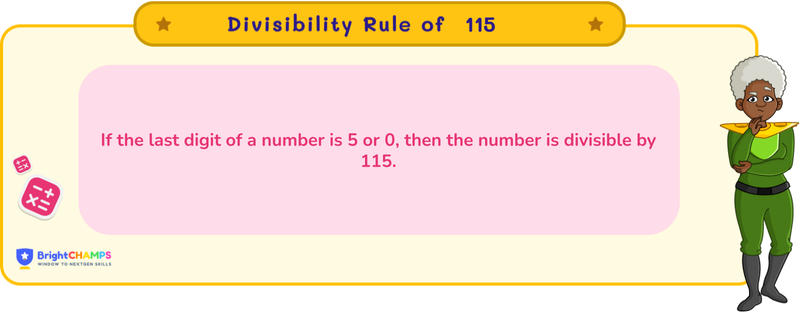
 224 Learners
224 LearnersLast updated on May 26th, 2025

Divisibility Rule of 115

The divisibility rule is a way to determine if a number is divisible by another number without using the division method. In real life, we can use the divisibility rule for quick math, dividing things evenly, and sorting things. In this topic, we will learn about the divisibility rule of 115.
What is the Divisibility Rule of 115?
The divisibility rule for 115 is a method by which we can find out if a number is divisible by 115 or not without using the division method. Check whether 1840 is divisible by 115 using the divisibility rule.
Step 1: Check if the number is divisible by both 5 and 23.
For divisibility by 5, the last digit of the number should be 0 or 5. In 1840, the last digit is 0.
For divisibility by 23, divide the number by 23. 1840 ÷ 23 = 80, which is an integer.
Step 2: Since 1840 ends in 0 and is divisible by 23, it is divisible by 115.

Tips and Tricks for Divisibility Rule of 115
Understanding the divisibility rule helps to master division. Let’s learn a few tips and tricks for the divisibility rule of 115.
Know the multiples of 115:
Memorize the multiples of 115 (115, 230, 345, 460, etc.) to quickly check divisibility.
Check divisibility by 5 first:
If the last digit is not 0 or 5, the number is not divisible by 115.
Use the division method for verification:
Students can use the division method to verify and crosscheck their results, which will help them to verify and also learn.
Repeat the process for larger numbers:
For larger numbers, ensure divisibility by both 5 and 23. For example, check if 5750 is divisible by 115:
The last digit is 0, so it's divisible by 5.
Divide 5750 by 23: 5750 ÷ 23 = 250, which is an integer.

Common Mistakes and How to Avoid Them in Divisibility Rule of 115
The divisibility rule of 115 helps us quickly check if a given number is divisible by 115, but common mistakes, like calculation errors, lead to incorrect conclusions. Here are some common mistakes and how to avoid them:

Divisibility Rule of 115 Examples

Problem 1
Is 2300 divisible by 115?

Yes, 2300 is divisible by 115.
Explanation
To determine if 2300 is divisible by 115, check if 2300 can be broken down into smaller parts that are multiples of 115.
1) Since 115 is a divisor of 1150, notice that 2300 is 1150 × 2.
2) Thus, 2300 is divisible by 115.

Problem 2
Check the divisibility rule of 115 for 3450.

No, 3450 is not divisible by 115.
Explanation
To verify the divisibility of 3450 by 115, consider the following:
1) Break down 3450 into parts. Compare with the product of 115.
2) 3450 ÷ 115 = 30, which is not an integer. Therefore, 3450 is not divisible by 115.

Problem 3
Is -920 divisible by 115?

Yes, -920 is divisible by 115.
Explanation
To check if -920 is divisible by 115, ignore the negative sign and verify divisibility:
1) Break down 920 into parts. Notice 920 ÷ 115 = 8, an integer.
2) Thus, -920 is divisible by 115.

Problem 4
Can 4830 be divisible by 115 following the divisibility rule?

No, 4830 is not divisible by 115.
Explanation
To determine if 4830 is divisible by 115, perform the division:
1) 4830 ÷ 115 = 42, which is not an integer.
2) Therefore, 4830 is not divisible by 115.

Problem 5
Check the divisibility rule of 115 for 5750.

Yes, 5750 is divisible by 115.
Explanation
To check if 5750 is divisible by 115, consider:
1) 5750 ÷ 115 = 50, which is an integer.
2) Thus, 5750 is divisible by 115.


FAQs on Divisibility Rule of 115
1.What is the divisibility rule for 115?
2.How many numbers are there between 1 and 1000 that are divisible by 115?
3.Is 345 divisible by 115?
4.What if I get a decimal after dividing by 23?
5.Does the divisibility rule of 115 apply to all integers?
6.How can children in Singapore use numbers in everyday life to understand Divisibility Rule of 115?
7.What are some fun ways kids in Singapore can practice Divisibility Rule of 115 with numbers?
8.What role do numbers and Divisibility Rule of 115 play in helping children in Singapore develop problem-solving skills?
9.How can families in Singapore create number-rich environments to improve Divisibility Rule of 115 skills?
Important Glossaries for Divisibility Rule of 115
- Divisibility rule: A set of guidelines used to determine if a number is divisible by another number.
- Multiples: Results obtained by multiplying a number by an integer. For example, multiples of 115 are 115, 230, 345, etc.
- Integer: A whole number that can be positive, negative, or zero.
- Division: The process of determining how many times one number is contained within another.
- Verification: The process of confirming the accuracy of a calculation or result.
Explore More numbers
About BrightChamps in Singapore


Hiralee Lalitkumar Makwana
About the Author
Hiralee Lalitkumar Makwana has almost two years of teaching experience. She is a number ninja as she loves numbers. Her interest in numbers can be seen in the way she cracks math puzzles and hidden patterns.
Fun Fact
: She loves to read number jokes and games.




